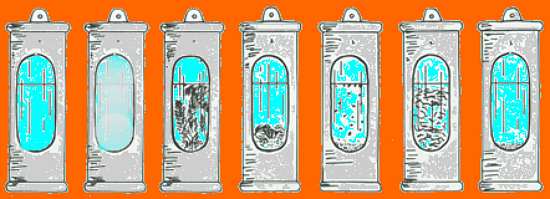 |
 |
| Home | Welcome | What's New | Site Map | Glossary | Weather Doctor Amazon Store | Book Store | Accolades | Email Us |
 | |||||||||
FitzRoy's Storm GlassWhen Robert FitzRoy took HMS Beagle out on its second voyage in 1831, he carried a number of different barometers. Among the studies FitzRoy undertook on the voyage was the application of the various barometers and storm glasses in widespread use during the 1800s to weather forecasting at sea. Barometers, of course, are instruments designed to measure atmospheric pressure, and that pressure, or more correctly the changes in air pressure, are important in short-term weather forecasting. A few decades after Beagle's return, FitzRoy would be instrumental in placing barometers and instructions for their use around the British coastline. One type of storm glass is a form of barometer that does not show absolute pressure but indicates changes in air pressure over time. They are generally a glass vessel looking like a stretched teapot sealed at one end and filled with water, usually coloured for visibility. Known by many names including the weather glass and water barometer, it offers an aid to simple weather forecasting by showing pressure changes as water rises or falls in its "spout." I have written about this form of storm glass elsewhere: "The Weather Glass." The form of storm glasses with which FitzRoy is linked is much different. These chemical storm glasses, also known as storm bottles, are hermetically sealed glass tubes containing a supersaturated mixture of chemicals. They likely appeared around 1750 invented by an alchemist for Italian sailors. The instrument was mounted on the ship's mast as a storm warning instrument. Their first documented shipboard use dates to the Beagle's famed 1831-36 circumnavigation. FitzRoy wrote in The Weather Book: "Considerably more than a century ago, what were called 'storm glasses' were made in this country. Who was the inventor, is now very uncertain; but they were sold on old London Bridge..." in the shop "Under the Goat and Compasses." The premise of the storm glass is that changing weather, affects the solubility of the mixture, mostly due to changes in temperature. (Some believe changing pressure alters the storm glass mixture, but if the glass tubes are sealed, the pressure within should not change with variations in atmospheric pressure. Under the changing weather conditions, users believed, the super-saturated mixture of chemicals produced crystals in strange, fascinating organic and crystalline shapes, or alternately, existing crystals would melt back into solution. The functioning of the storm glass is, however, not fully understood even today, and they are now more a curiosity than a practical instrument. To quote from his 1863 tome The Weather Book: "Since 1825 we have generally had some of these vials...when it was fairly demonstrated that if fixed, undisturbed, in free air, not exposed to radiation, fire, or sun, but in the ordinary light of a well-ventilated room, or preferably in the outer air, the chemical mixture in a so-called storm glass varies in character with the direction of the wind — not its force... though it may so vary from another cause, electrical tension. As the atmospheric current veers toward, comes from, or is only approaching from the polar direction, this chemical mixture — if closely, even microscopically watched — is found to grow like fir, or fern leaves — or like hoar frost — or even large but delicate crystallisations..." FitzRoy found one specific mixture, containing camphor, ammonia, alcohol, potassium nitrate, and water, more suitable for weather forecasting than others. In The Weather Book, FitzRoy described the various crystal shapes and patterns that would develop within the storm glass according to different wind directions and weather conditions.  Image Used By Permission from Stig LarsenClear liquid means bright weather; dim liquid, rain. Crystals at the bottom presage frost. Large flakes mean overcast or, in winter, snowy skies. If the liquid contains small dots, humid or foggy conditions can be expected. As its name implies, many believed the instrument was especially sensitive to the coming of stormy weather. Thus, if small stars are seen in dim liquid, thunderstorms can be expected. Threads in the upper part foretell wind. If the substance lies to one side, expect storm or wind from the opposite direction. FitzRoy included a storm glass as part of the FitzRoy barometer assembly. These barometers were distributed to every British port so that it could be consulted by seamen before embarkation. Many of these stone huts housing these mercury barometers are still visible in many fishing harbours. The storm glass, glass cylinders with brass caps, can be seen clamped onto the lower left of the barometer assembly. Learn More From These Relevant Books
|
|||||||||
 |
To Purchase Notecard, |
Now Available! Order Today! | |
 |
 |
NEW! Now |
The BC Weather Book: |


